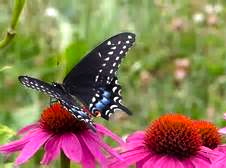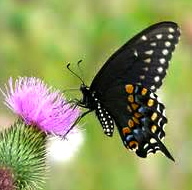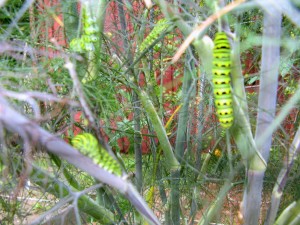Some time ago I noticed that my fennel bush was crawling with caterpillars. They had distinctive green, yellow, and black stripes in a dot and dash formation somewhat like Morse code. Despite the fact that they were devouring my fennel fronds with gluttonous ferocity, I found them quite pretty. When I took one down to Ward’s Nursery in Great Barrington and mentioned that I’d found it on the fennel, it was identified as the caterpillar of the Eastern Black Swallowtail butterfly which feeds off anything in the carrot family — parsley, dill, Queen Anne’s Lace, fennel, and anise. In fact, its western counterpart is called the Anise Swallowtail because — well — I think I’ve established its eating preferences.
When I looked up Eastern Black Swallowtails in my Audubon Butterfly Guide, I discovered that they’re very common and smaller than most North American Swallowtails (the wingspan is only 3 inches across), but that doesn’t make them any less beautiful. Their wings are the black and blue of old stained glass windows with bright touches of yellow and orange dappling the outer edges. The female and male display subtle differences: the wings of the female have more blue, the males’ wings are spotted with two rows of yellow.
 Then, practically overnight, the caterpillars were gone from my garden, leaving my fennel plant stripped but still upright. The fronds began to grow back. But I missed watching the caterpillars feed. I missed this small but immediate reminder that nature is constantly performing an intricate balancing act. I’m not sure where they went to in the interim, but I recently noticed dozens of black wings in my sun garden, fluttering over the echinacea and competing with the hummingbirds for a turn at the monarda. There they were! The Eastern Black Swallowtail caterpillars had made the trip from vegetable bed to perennial border, transforming themselves into butterflies along the way.
Then, practically overnight, the caterpillars were gone from my garden, leaving my fennel plant stripped but still upright. The fronds began to grow back. But I missed watching the caterpillars feed. I missed this small but immediate reminder that nature is constantly performing an intricate balancing act. I’m not sure where they went to in the interim, but I recently noticed dozens of black wings in my sun garden, fluttering over the echinacea and competing with the hummingbirds for a turn at the monarda. There they were! The Eastern Black Swallowtail caterpillars had made the trip from vegetable bed to perennial border, transforming themselves into butterflies along the way.
If you visit the new Butterfly House at Project Native in Housatonic, Mass. (https://projectnative.org), you’ll find out more about the critical symbiotic relationship between plants and butterflies.



